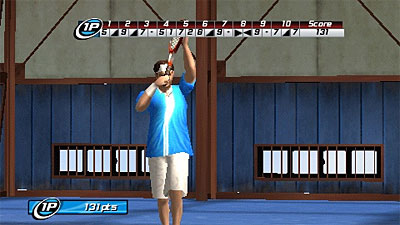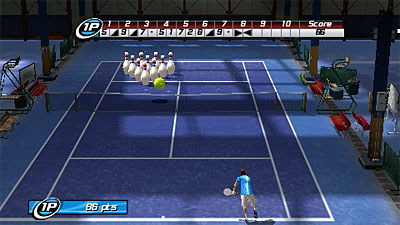Being told that you’re good at Virtua Tennis often requires a backhanded compliment
There are a lot of reasons to like Virtua Tennis 3, but most of those reasons can be found in Virtua Tennis: World Tour. Despite a few decent refinements, Virtua Tennis 3 hasn’t really changed all that much. The graphics, the gameplay, the multiplayer options, and the mini-games are so similar that you would swear at first glance that you’re playing the same game. Only those that can appreciate the subtle differences in both control and in the expanded career mode will be likely to agree that this is a worthwhile purchase. There are still a few technical issues that I would like to see corrected in the next game. Until such time, relegate this game to rental status.

Improvements are marginal, although there are some new additions such as mini-games and the career mode, but there’s little improvement to the mechanics. There are still some command and collision detection issues which make hitting the ball a hit or miss proposition. The control system couldn’t be easier to learn, and in theory it works well as you can modify the various hits and spins that you apply to the ball by your character’s position on the court. There are also a couple of button commands that are used to determine the power of your shot. Simply move at the spot where you believe the ball is going to arrive and begin a little button mashing. The longer you are at the spot before the ball arrives, the more powerful the shot. If you get there a split second before the ball, it will be a weaker return. Likewise, if you have to reach for the ball you can expect an even weaker return, if one at all.
There are only three main buttons to press which result in a variety of shots including a lob, top spin, slice, slam, and drop. Aiming is performed by the stick or the D-pad. While the stick feels the best, the D-pad is more accurate. Serves are activated by pressing one button to build the power and another press to release it. Control issues arise when you fail to hit the ball even though you’re in the correct position. Sometimes it will register the wrong kind of shot or a weaker shot even though you were waiting at the spot anticipating a powerful return. For the average player, these might seem like minor issues, and there are those that probably won’t even notice these flaws. But when you begin to catch on that A.I. doesn’t make as many mistakes as you apparently do, you will begin to think that something is wrong. At first, the challenge is easy. You will simply outplay the A.I. The only way you’ll lose is by making mistakes. Later, as things heat up, you can’t help but notice the unfair advantage the A.I. has. However, you can still play a good, fast, and fun game of tennis by being in the right place at the right time.

Career mode has been made deeper. In this mode, you’ll create your own tennis pro and move him or her through the ranks, starting at last place out of 300. There are three ways to improve your ranking: winning tournaments, building stats, and practicing your craft. You’ll get a lot of practice in the career mode whether it’s through replaying matches, taking part in the tutorial, or playing the mini-games. You will play against real-life tennis pros, some of which play very different style games. You will have to learn to adapt to their style which will give you more experience to take on other opponents. You will also run into these same pros over and over as there are no generic players to go up against.
The tutorial is actually a Tennis Academy where you are instructed to work on various techniques. You will be given an exercise designed to improve your skill in a certain area. Complete this exercise three times and your player will earn stats in that skill which may include running, more powerful serves, or more accurate returns. Leveling-up your player is the only way you’re going to make it to number one.

Another source of attribute points and practice can be found in the mini-games. These are all variations of the same theme. Think of them as advanced versions of Arkanoid. In each game, you will have to defend and deflect balls away from yourself and/or toward another target. In some cases, those targets can be large barrel drums or bowling pins. In another game you’ll have to blow up aggressive robots before they shoot you, while another mini-game has you running around collecting fruit while trying to avoid giant tennis balls falling off of a truck. These games increase in difficulty as you progress, but the harder they are the more points you can accumulate. These mini-games are totally addicting, and have been a staple of the series since its inception. While they are similar to what’s been offered in the past, it would be a huge oversight not to include them.
Tournaments take place all over the world. The announcers will even speak in the appropriate language of the country that you’re playing in. You can enter into single and doubles matches. Courts include a variety of surfaces such as grass, clay, and harder surfaces such as asphalt or wood. The further you rise up in the ranks, the longer the matches become. There’s a lot more volleying and running around. This will decrease your stamina. You can drink an energy drink to replenish your stamina but it will make you prone to injury. Either way, if you get injured or run out of energy drinks, then you’ll just have to take some time off. The interface will let you know when you’ve been injured and will schedule matches accordingly. You will also receive information from coaches, fans, and other organizations via email. You’ll get tips, information on your ranking, and awards.

There’s really no excuse for the exclusion of online play. This has simply got to be included in the next version. The ad hoc system allows four players to take part in doubles matches. There is some slowdown, but it’s just barely noticeable. The players look good and even resemble their real-life counterparts. However, they tend to look worse the closer that you zoom in on them. Movements are graceful, and different animations are displayed, indicative of their playing styles. This is most evident during serves. The courts look great, but the crowds look like a washed-out water painting. At least they cheer at the appropriate places. The sound effects are good and include some riffy guitar music as well as some groans and grunts from the players.
As a further refined version of Virtua Tennis: World Tour, this game is easily the best available for any handheld system. But having said that, it may not be enough of a difference for fans of the last game to part with their money. Rent this for the time being and hold out for an online version.
Features
|
